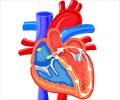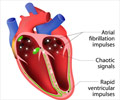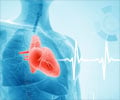For the very first time, a technique normally used to treat brain aneurysms, is now used to treat life-threatening arrhythmias.

The research is published in the February issue of Heart Rhythm, the official journal of the Heart Rhythm Society, and is highlighted on the cover.
Many people suffer from ventricular arrhythmias, which are one of the leading causes of death in the U.S., claiming 400,000 lives annually. These arrhythmias can usually be controlled by medications, by implanting a cardioverter defibrillator device that automatically shocks the heart back into normal rhythm, or by a procedure called catheter ablation, which involves a targeted burn or the application of extreme cold to the tiny area of the heart causing the irregular heart beat.
None of these traditional treatments worked for the two patients featured in this report, who suffered from a severe form of arrhythmia called ventricular tachycardia, which causes a dangerous rapid heartbeat.
Instead, the UCLA team of cardiologists and interventional neuro-radiologists used coil embolization, a minimally invasive method originally developed at UCLA and now commonly used around the world to treat brain aneurysms.
"We have to think outside the box to help patients with severe arrhythmias located in hard-to-reach areas of the heart," said senior author Dr. Kalyanam Shivkumar, director of the UCLA Cardiac Arrhythmia Center and a professor of medicine and radiological sciences at the
Advertisement
As is common with other arrhythmia procedures, the team first took colorful images of the electrical system of each patient's heart using wires within the arteries of the heart muscle, which helped pinpoint the exact origin of the arrhythmia and served as a roadmap for the medical team.
Advertisement
Once positioned, the team carefully guided tiny, soft-metal coils — just slightly larger than the width of a human hair — through the catheter and into the arteries. The doctors filled each targeted artery with coils, thereby cutting off the blood supply to the region where the arrhythmia originated and stopping it.
Similarly, during coil embolization for a brain aneurysm — an abnormal bulge in a blood vessel caused by a weakening in the vessel wall — coils are guided into the aneurysm to fill it. In this way, the aneurysm is sealed off, eliminating the danger that the ballooning area of the vessel will burst in the brain. This procedure also employs a catheter inserted in the groin.
"We are seeing more cross-over into different medical specialties of these cutting-edge techniques that are able to target and navigate delicate areas in the body, such as the brain and heart," said Dr. Gary Duckwiler, a professor of radiological sciences at the Geffen School of Medicine. "We look forward to future collaborations with cardiology."
Shivkumar lauded the partnership between the two medical specialties.
"Cardiac electrophysiologists are like fighter pilots in chasing and zeroing in on arrhythmias that can be tricky to track down," he said. "Once we have the arrhythmia's origin pinpointed — and if it's in a place that is hard to reach — we turn to help from interventional radiologists, who are truly like astronauts in developing novel treatments and ways to navigate through the body."
"More study will help determine if coil embolization could be used with a broader range of arrhythmia patients," said Dr. Noel Boyle, a clinical professor of medicine and director of the electrophysiology lab at the UCLA Cardiac Arrhythmia Center.
For now, the technique will be used to treat patients for whom conventional methods are not an option.
Dr. Rod Tung, an assistant professor of medicine and director of the ventricular tachycardia program at the UCLA Cardiac Arrhythmia Center, noted that both patients in the case study are doing well and have had no recurrences in several months.














